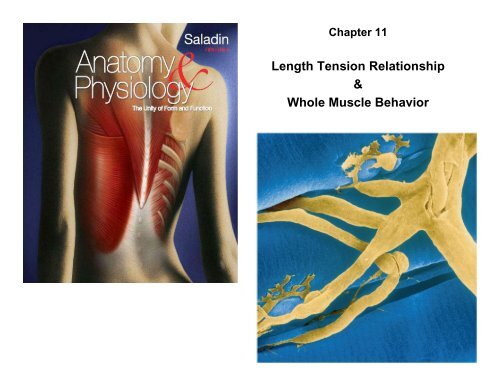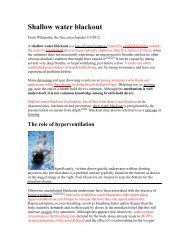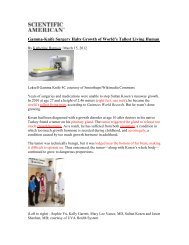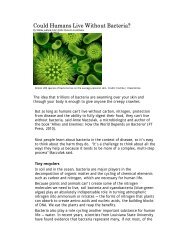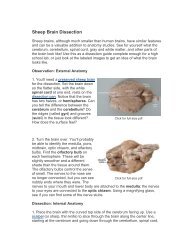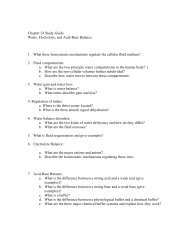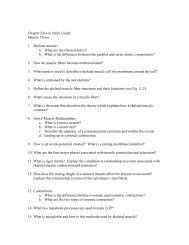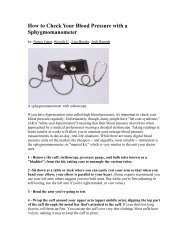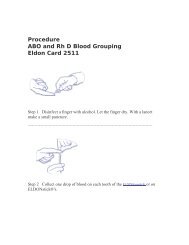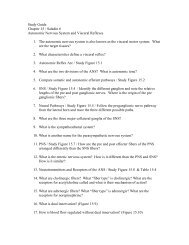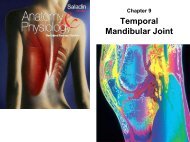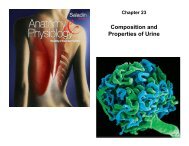Length Tension Relationship & Whole Muscle Behavior
Length Tension Relationship & Whole Muscle Behavior
Length Tension Relationship & Whole Muscle Behavior
- No tags were found...
You also want an ePaper? Increase the reach of your titles
YUMPU automatically turns print PDFs into web optimized ePapers that Google loves.
Chapter 11<br />
<strong>Length</strong> <strong>Tension</strong> <strong>Relationship</strong><br />
&<br />
<strong>Whole</strong> <strong>Muscle</strong> <strong>Behavior</strong>
<strong>Length</strong>-<strong>Tension</strong> <strong>Relationship</strong><br />
• the amount of tension generated by a<br />
muscle and the force of contraction<br />
– depends on how stretched or contracted it was<br />
before it was stimulated<br />
– proper distance between Z discs<br />
• if overly contracted at rest<br />
• a weak contraction results<br />
• thick filaments too close to Z discs and can’t slide<br />
• if too stretched before stimulated<br />
• a weak contraction results<br />
• little overlap of thin and thick does not allow for<br />
very many cross bridges to form
<strong>Length</strong>-<strong>Tension</strong> <strong>Relationship</strong><br />
• optimum resting length<br />
– produces greatest force when muscle<br />
contracts<br />
• muscle tone<br />
– central nervous system continually monitors<br />
and adjusts the length of the resting muscle,<br />
– maintains a state of partial contraction called<br />
muscle tone<br />
– maintains optimum length and makes the<br />
muscles ideally ready for action
<strong>Length</strong>-<strong>Tension</strong> <strong>Relationship</strong><br />
Optimum resting length<br />
(2.0–2.25µm)<br />
z<br />
z<br />
Overly contracted<br />
z<br />
z<br />
z<br />
Overly stretched<br />
z<br />
1.0<br />
<strong>Tension</strong> (g) generated<br />
upon stimulation<br />
0.5<br />
0.0<br />
1.0 2.0 3.0 4.0<br />
Sarcomere length (µm) before stimulation
<strong>Behavior</strong> of <strong>Whole</strong> <strong>Muscle</strong>s<br />
• This is the response of a muscle<br />
to a weak electrical stimulus seen<br />
in frog gastrocnemius - sciatic<br />
nerve preparation<br />
• myogram – a chart of the timing<br />
and strength of a muscle’s<br />
contraction<br />
• weak, subthreshold electrical<br />
stimulus causes no contraction<br />
• threshold<br />
– the minimum voltage necessary<br />
to generate an action potential in<br />
the muscle fiber<br />
– produces a contraction<br />
– twitch – a quick cycle of<br />
contraction and relaxation when<br />
stimulus is at threshold or higher<br />
<strong>Muscle</strong> tension<br />
Copyright © The McGraw-Hill Companies, Inc. Permission required for reproduction or display.<br />
Time of<br />
stimulation<br />
Contraction<br />
phase<br />
Latent<br />
period<br />
Time<br />
Relaxation<br />
phase
Phases of a Twitch Contraction<br />
• latent period<br />
– 2 msec delay between the onset of stimulus and onset of<br />
twitch response<br />
– time required for excitation, excitation-contraction coupling<br />
and tensing of elastic components of the muscle<br />
– internal tension – force generated during latent period and<br />
no shortening of the muscle occurs<br />
• contraction phase<br />
– phase in which filaments slide and the muscle shortens<br />
– once elastic components are taut, muscle begins to produce<br />
external tension – in muscle that moves a load<br />
– short-lived phase<br />
• relaxation phase<br />
– SR quickly reabsorbs Ca +2<br />
– myosin releases the thin filaments and tension declines<br />
– muscle returns to resting length<br />
– entire twitch lasts from 7 to 100 msec
Contraction Strength of Twitches<br />
• twitches vary in strength depending upon<br />
– stimulus frequency<br />
• stimuli arriving closer together produce stronger<br />
twitches<br />
– concentration of Ca +2<br />
• Calcium in sarcoplasm can vary the frequency<br />
– length / tension<br />
• how stretched muscle was before it was stimulated<br />
– temperature<br />
• of the muscles – warmed-up muscle contracts more<br />
strongly – enzymes work more quickly<br />
– pH<br />
• lower than normal pH of sarcoplasm weakens the<br />
contraction<br />
• fatigue<br />
– Hydration<br />
• state of hydration of muscle affects overlap of thick<br />
& thin filaments
Contraction Strength of Twitches<br />
• subthreshold stimulus<br />
– no contraction at all<br />
• threshold intensity and above<br />
– a twitch is produced<br />
– twitches caused by increased<br />
voltage are no stronger than those<br />
at threshold
Twitch Strength & Stimulus Frequency<br />
Copyright © The McGraw-Hill Companies, Inc. Permission required for reproduction or display.<br />
Twitch<br />
<strong>Muscle</strong> twitches<br />
(a)<br />
Stimuli<br />
• when stimulus intensity (voltage) remains<br />
constant twitch strength can vary with the<br />
stimulus frequency<br />
• up to 10 stimuli per second<br />
– each stimulus produces identical twitches and full<br />
recovery between twitches
Twitch Strength & Stimulus Frequency<br />
Copyright © The McGraw-Hill Companies, Inc. Permission required for reproduction or display.<br />
Treppe<br />
(b)<br />
• 10-20 stimuli per second produces treppe (staircase) phenomenon<br />
– muscle still recovers fully between twitches, but each twitch develops more<br />
tension than the one before<br />
– stimuli arrive so rapidly that the SR does not have time between stimuli to<br />
completely reabsorb all of the Ca +2 it released<br />
– Ca +2 concentration in the cytosol rises higher and higher with each<br />
stimulus causing subsequent twitches to be stronger<br />
– heat released by each twitch cause muscle enzymes such as myosin<br />
ATPase to work more efficiently and produce stronger twitches as muscle<br />
warms up
Incomplete Tetanus<br />
Incomplete tetanus<br />
• 20-40 stimuli per second produces incomplete tetanus<br />
– each new stimulus arrives before the previous twitch is over<br />
– new twitch “rides piggy-back” on the previous one generating higher<br />
tension<br />
– temporal summation – results from two stimuli arriving close together<br />
– wave summation – results from one wave of contraction added to<br />
another<br />
– each twitch reaches a higher level of tension than the one before<br />
– muscle relaxes only partially between stimuli<br />
– produces a state of sustained fluttering contraction called incomplete<br />
tetanus
Complete Tetanus<br />
Complete tetanus<br />
Fatigue<br />
• 40-50 stimuli per second produces complete tetanus<br />
– muscle has no time to relax at all between stimuli<br />
– twitches fuse to a smooth, prolonged contraction called complete tetanus<br />
– a muscle in complete tetanus produces about four times the tension as a<br />
single twitch<br />
– rarely occurs in the body, which rarely exceeds 25 stimuli per second<br />
– smoothness of muscle contractions is because motor units function<br />
asynchronously<br />
• when one motor unit relaxes, another contracts and takes over so the<br />
muscle does not lose tension
Contraction Strength of Twitches<br />
Its not exactly true that muscles obeys an all-ornone<br />
law ( i.e. contracting to its maximum or not at<br />
all)<br />
Electrical excitation of a single muscle fiber will<br />
follow the all-or-none law<br />
A muscle organ made up of many muscle<br />
fibers may not necessarily follow the all or<br />
none law<br />
This will depend on the strength of the<br />
electrical signal delivered by the nerve!
Recruitment and Stimulus Intensity<br />
Copyright © The McGraw-Hill Companies, Inc. Permission required for reproduction or display.<br />
Stimulus voltage<br />
Threshold<br />
<strong>Muscle</strong>s need to contract with<br />
variable strengths for different<br />
tasks<br />
1 2 3 4 5 6 7 8 9<br />
Stimuli to nerve<br />
Proportion of nerve fibers excited<br />
<strong>Tension</strong><br />
This is achieved by the<br />
1 2 3 4 5 6 7 8 9<br />
relationship between the<br />
nerve and the muscle<br />
organ<br />
• stimulating the nerve with higher and higher voltages produces<br />
stronger contractions<br />
– higher voltages excite more and more nerve fibers in the motor nerve<br />
which stimulates more and more motor units to contract<br />
Responses of muscle<br />
Maximum contraction<br />
Requires different force of<br />
contraction to pick up a<br />
bowling ball or a ping pong<br />
ball<br />
• recruitment or multiple motor unit (MMU) summation – the<br />
process of bringing more motor units into play


